For The GEF’s Naoko Ishii, Sustainability Must be a Core Global Value
The Global Environment Facility or “GEF” unites 182 government members, in partnership with multiple international institutions, nongovernmental organizations, and the private sector, with the goal of addressing global environmental issues.
Established in 1991, the GEF has grown to become the world’s largest funder of projects to improve the global environment. The GEF has directly allocated $10.5 billion in project finance and supplemented more than $51 billion in co-financing, for more than 2,700 projects in over 165 developing countries. Through its Small Grants Program (SGP), the GEF has also made more than 12,000 grants directly to nongovernmental and community organizations, totaling $495 million.
The following is an interview with Dr. Naoko Ishii of Japan, who was recently elected as the new CEO and Chairperson of the Global Environment Facility, by the unanimous decision of the GEF’s governing council.
AN INTERVIEW WITH NAOKO ISHII
Mongabay: To begin, how does it feel to be named the new CEO and Chairperson of the GEF? What are your motivations and interests in advancing the cause of global sustainable development?
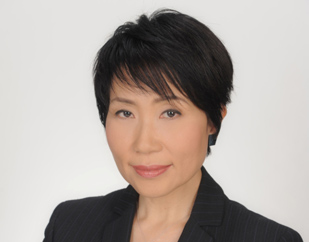 Naoko Ishii |
Dr. Naoko Ishii: I am extremely honored to be elected as the new CEO and Chairperson of the GEF. The possibilities offered by this position are really just beginning to set in with me. It is such a tremendous opportunity to pursue what has become the focus of my career and my passion: helping our world to develop on a sustainable basis. I believe the GEF can play a very important role when we step up to work in greater cooperation with NGOs, governmental groups and, most importantly, the private sector.
After 30 years of work with the Japanese Ministry of Finance (MOF) and several leading global development policy groups, I am fully convinced that global development and environmental issues, which used to be treated as opposed to each other, are deeply interlinked and co-dependent. Going forward, these interests must “go hand in hand.” I am excited because fostering this important insight is an area where I feel the GEF can really make a difference.
Mongabay: You have had a long career at the Japanese Ministry of Finance and with other international institutions. How has this experience prepared you for your new role at the GEF?
Dr. Naoko Ishii: In some ways, it feels like I have been preparing for this GEF position my whole life. For the last 30 years, I worked for development either at the Japanese MOF or at institutions like the IMF and World Bank. Now, I feel approaching global development from the environmental community will be even more productive.
 The GEF |
The key challenge will be to embed stronger environmental values within the cores of the three areas that comprise sustainable development: economic progress, social improvement, and environmental sustainability. My goal is for all three areas of sustainable development to make working together to solve global environmental challenges their top priority. I am hoping my experience and connections within these three groups will be both advantageous and effective in fostering an even stronger commitment to sustainability and the environment.
Mongabay: It is thought by many in the global geopolitical arena that your nomination, and the strong show of support for your appointment at the GEF by the Government of Japan, is intended to signal “Japan Inc.’s” interest in a leadership role in global sustainable resource management and infrastructure development. Do you feel that there is basis for this line of thinking? Also, do you feel that a leadership role is important for Japan?
Dr. Naoko Ishii: As you may know, Japan has long worked toward a commitment to a healthy environment and sustainable development, and this pursuit continues to be a key focus of both the Japanese Government and the country’s private sector. During the election process for the CEO position at the GEF, I had the privilege of visiting many developing countries in Africa, Asia, and Latin America. I was pleased to learn in regard to the environment, there was a very high level of trust globally for Japanese governmental interests and the Japanese private sector. In general, when Japanese firms develop offshore factories and operations, they uphold a very a high standard of sustainability and regard for the environment.
Japan is a nation rich in “human capital,” but our country has limited natural resources. We have become a nation that is very trade focused, as we must import many of the raw materials that are used in our society. Japan is also a very densely populated country. The limited resources of land available for development and the need to import much of our raw materials pressed Japan into developing sustainable and very efficient resource management practices. This resource management efficiency is a strength that we can bring to other parts of the world.
Mongabay: It is also felt that your nomination by the Government of Japan is intended to foster new role models for the women of Japan and across Asia. Do you think there is need for new role models and, if so, why do you feel this is important?
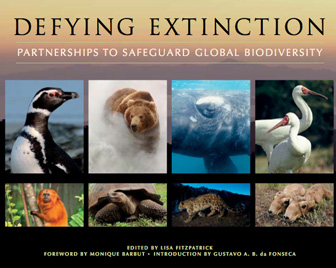 Of all environmental ills, biodiversity loss is the only one likely to be irreversible. Unfortunately, biodiversity is being lost today at a scale that will threaten the life-support systems that sustain societies and economies, particularly in the developing world. The Global Environment Facility was established as the financial mechanism of the Convention on Biological Diversity. Since 1991, the GEF has invested over $2.9 billion, with $8.3 billion in co-financing, to support implementation of more than 1000 projects in more than 155 countries, to conserve and sustainably use biodiversity. Defying Extinction [PDF highlights some of the most threatened pieces of the fabric of biodiversity, specifically individual species at risk. |
Dr. Naoko Ishii: I have been asked this question before, and I find it very interesting. I don’t consider myself a “role model,” although it is true I pursued a career path that was very different from most of my colleagues at the MOF. I chose to focus on a specific area that was very compelling to me: work in global development. The typical route for most at the MOF is to pursue a multidisciplinary approach on the path to becoming a general manager. By choosing a specific area of focus, I limited my opportunities to become a top level bureaucrat, However, I found my path to be much more rewarding because I was working in an area which I felt offered real contributions, and this has inspired a great deal of personal satisfaction.
Rather than being considered a role model, maybe I could be seen as an example of a person who found some success and tremendous satisfaction by working along a path that was one of my own making, where I followed my interests, my passions, and my heart. When it comes to environmental concerns, I feel this is an area that has to transcend gender issues. I hope to inspire in young people, regardless of gender, a strong interest in our global environment, especially at this point in time when conservation has become so critical. I firmly believe environmental responsibility and a strong sense of global stewardship need to be instilled as core values for this generation and those that follow.
Mongabay: Female leaders have played very strong roles in global conservation and sustainable development. Notable female conservation leaders include Dr. Jane Goodall, Dr. Wangari Maathai of Kenya, Dr. Laurie Marker in Namibia, LiQuan in China, Belinda Wright and Dr. Krithi Karanth in India, etc. Can your offer any insights on why these women have excelled in these areas?
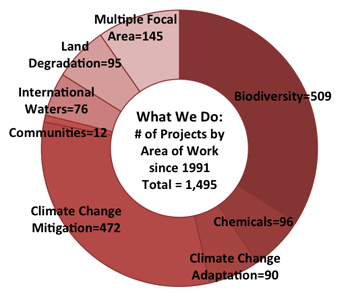 The GEF’s Areas of Work. |
Dr. Naoko Ishii: I don’t know that the tremendous success of these individuals in conservation is directly related to the specific issue of gender. Rather, I suspect their success is attributable to the fact that many of these individuals have had to pursue their own unique paths in the face of cultural, organizational, or structural limitations. And as they followed their own paths, they brought new, valuable ideas and methods to the environmental sector. In fields like conservation and sustainable development (that face numerous and growing challenges), a free flow of new ideas and practices is essential. My feeling is that these individuals were “change agents” that earned a leadership role by bringing valuable new ideas and perspective to areas that had great need for new insights and approach. Their considerable success is less a function of gender, but more a reflection of an evolving global society where all individuals who are motivated to contribute have the opportunity to do so. This line of thinking is one approach I hope to greatly foster in my new role at the GEF.
Mongabay: What are some of your other hopes and goals for the GEF, as you step into your new role at the helm of this institution?
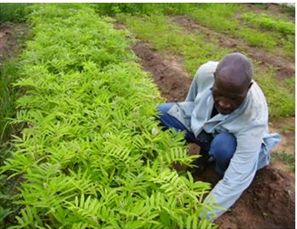 The GEF introduces organic farming to reduce the use of pesticides in Zimbabwe |
Dr. Naoko Ishii: I hope that the GEF will expand its role as a lead coordinator within the environmental sector. I would like to see the expansion of global certification systems for sustainably managed-forests, fisheries, and agricultural products. Further developing unified standards will foster greater global natural resource sustainability.
There has been tremendous and growing interest in the global environment and many different groups have stepped up with very important contributions in this area. My hope is that the GEF can further collaboration and innovation within the environmental management community, and also work in greater harmony with the private sector around the world. When it comes to the environment, we are all truly stakeholders in sustainable development. My goal is to encourage sustainability as a core global value, with the realization that we will all share in the benefits offered by a healthy global environment.
Related articles
Charting a new environmental course in China
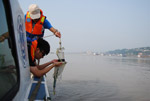
(05/21/2012) Founded in 1951, The Nature Conservancy (TNC) works in more than 30 countries and
has projects in all 50 of the United States. The Conservancy has over one million
members, and has protected more than 119 million acres of wild-lands and 5,000 miles
of rivers worldwide. TNC has taken an active interest in China, the world’s most
populated nation, and in many important ways, a critical center of global development.
The following is an interview with multiple directors of The Nature Conservancy’s China
Program.
Interview with conservation legend, Richard Leakey

(11/28/2011) Following in his family’s footsteps, Dr. Richard Leakey, is considered the heir to the scientific legacy of his parents, Louis and Mary Leakey, icons in the field of paleoanthropology. Dr Richard Leakey has been credited with some of the field’s most successful paleoanthropologic finds, including a near complete, groundbreaking, Homo Erectus fossil dubbed ‘Turkana Boy’. The scientific contributions of the Leakey family have reshaped our views of the origins of mankind and shed new light on the history and shared ties of the human family.
Aloha, and welcome to the planet’s extinction capital

(11/07/2011) Hawaii evokes images of a tropical paradise where fragrant flowers, vivid colors, exotic plants, birds, and
fish abound. Unfortunately, much of Hawaii’s original native flora and fauna has disappeared since the
arrival of Europeans in the 18th Century. Hawaii now has the dubious distinction as having become the
planet’s extinction capital, having lost more than 55 endemic species (mostly native forest birds) which
account for nearly one third of recorded of bird extinctions since the 1700s.